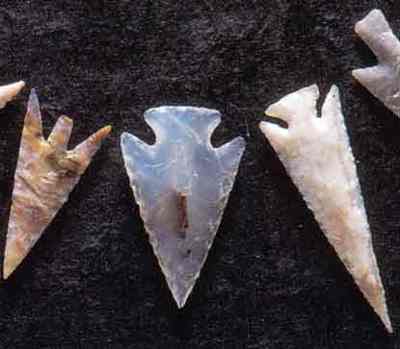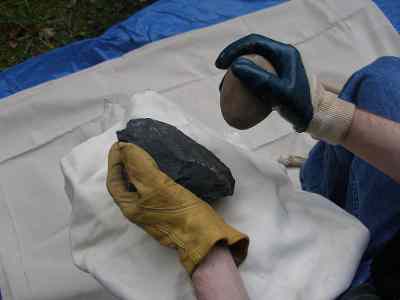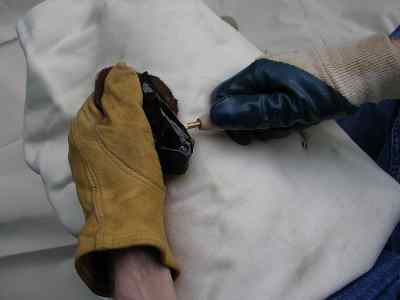Flint Knapping

What Is Flint Knapping
Flint knapping is the shaping of rocks such as flint, chert, obsidian and other rocks into tools and weapons by chipping away at the stone in a controlled fashion. Ancient people used the art of flint knapping to make things such as arrowheads, axes, knives, spear points and gardening tools to name a few.The Tools
Knappers, as they are called, used a number of different tools to aid in the knapping process. Things such as hammers, antlers and rocks are all very commonly used tools. Hard hammering of larger stones is a technique used often with a hammer or other large stone to render large chunks of rock down into smaller more manageable pieces.Once a large rock has been broken down into what is a called a flake, then the tools used become smaller and more refined. Items such as deer antlers or small metal objects are used and these tools as a group are called pressure flakers. But depending on your rock you are trying to knap you might need a more powerful tool such as a hand held stone.
Safety
It may surprise you to know that in the past when flint knapping could be a person's profession that many of them died from silicosis. Busting rocks up repeatedly creates dust and breathing this in can be deadly. So, although the risk is much smaller for a recreational or occasional flint knapper, the threat is still there. Precautions like flint knapping outside or in well ventilated areas should be taken.Breaking rock is a violent endeavor and it is advisable to wear eye and hand protection. If not then you are likely to end up with cuts, scrapes and gashes as well as possibly damaging an eye.
Shoes and sturdy pants are also things I would not consider doing without.
Choosing the proper materials
Although most any stone can be knapped into a tool of some sort they are not all created equal. The best stones for making arrowheads include flint, chert, obsidian, jasper and others. These stones have the desirable characteristics of being brittle, free of cracks and fine grained.They must be brittle so they can be broken apart. Sort of like shattering glass but also fine grained so that the stone reacts to your strikes in a consistent manner.
Obviously the rock must be free of cracks or the tool will not last if you can even get it into the desired shape to start with.
Percussion Flaking
 Now that you have some crude tools and a rock selected you need to begin the process by doing what is known as percussion flaking. The percussion flaking process starts the tool making process. Percussion flaking will hopefully yield a rock with the general shape of the tool you are trying to make.
Now that you have some crude tools and a rock selected you need to begin the process by doing what is known as percussion flaking. The percussion flaking process starts the tool making process. Percussion flaking will hopefully yield a rock with the general shape of the tool you are trying to make.
As you will soon see the fractures of the struck material will break in a predictable manner. The breaks will occur in roughly a 100 degree cone from the point at which the rock was struck (50 degrees from the point of impact). This is called a Hertzian Cone. You will need to recognize this and use it to try to break / fracture the rock where you want it to fracture.
The goal of percussion flaking is not to yield you an arrowhead, but instead to provide you with a flake of rock that is roughly the size and shape of the tool you are trying to make. So, one core rock will yield a number of flakes for various tools.
Creating a flat surface on your core rock is necessary so that it is more controllable when struck. So to make this platform you will strike your core rock and it will fracture at roughly a 50 degree angle from the direction of impact.
Abrading
Abrading is the next step. Abrading is taking a new unworked flake and grinding down the thin fragile areas around its edges. To abrade your flake saw the flake against another stone. Grind the edge of your flake. Ideally the grinding stone will be softer than the flake.Pressure Flaking
 Pressure flaking is the next technique that is used to bring your tool into focus. After percussion flaking you have the general shape. Pressure flaking further refines you flake into its final detailed shape. You can view pressure flaking sort of like whittling the rock into its final shape. In short it is more precise.
Pressure flaking is the next technique that is used to bring your tool into focus. After percussion flaking you have the general shape. Pressure flaking further refines you flake into its final detailed shape. You can view pressure flaking sort of like whittling the rock into its final shape. In short it is more precise.
Pressure flaking involves pressing very hard on the edge of your flake with a tool such as an antler or metal nail, with the desired result being a narrow shard of rock to come off of the stone. Ancient man used antlers frequently for this. Modern flint knappers today will often use tools with a copper or brass tip. The bone or antler tools will work just fine but they are much more likely to break and will certainly wear down faster than the more modern counterpart.
Pressure flaking is the most difficult part of a flint knapping. You can expect to ruin a number of flakes while learning. Ancient flint knapping sites were often found with numerous broken tools that were discarded before they could ever be put to use. So if the Native Americans made mistakes, don't get discouraged when you do as well.
Notching
Notching is the last step in making arrowheads, spear points. The notches in the final product are needed to allow the arrowhead to be tied to the arrow shaft. Notches made by either pressure flaking or abrading or a combination of both.Tips:
Never make two flakes in the same place without abrading in between.The pressure flaking tool will wear down over time so periodically sharpen it while making your tool.
You can try a chisel and a pointed tipped tool to see which you need / prefer to use.
Stones that produce a higher pitch when tapped are generally easier to flint knap.
The easiest materials to start with include chert, flint, and obsidian. They leave smooth surfaces behind when fractured chip more easily than other stones.
